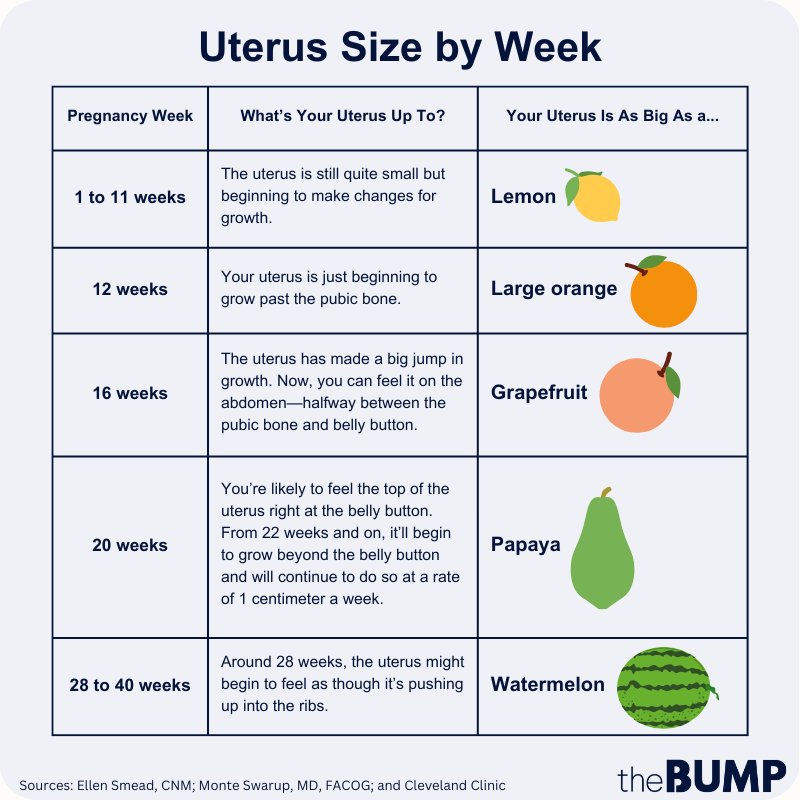How Much Does the Uterus Grow in Pregnancy?
While baby may be the main character in every pregnancy journey, the uterus deserves some of the spotlight too. This extraordinary organ can go from the size of a lemon to as big as a watermelon in the span of 40 weeks, shrink back down—and do it all over again in future pregnancies. Ahead, take a look at what you need to know about your uterus during pregnancy, including your uterus size by week, how your doctor measures your uterus and all the different positions it can take.
The uterus, also known as the womb, is a pear-shaped organ that sits inside a mom-to-be or birthing person’s pelvis, between the rectum and the bladder. Before pregnancy, the uterus is responsible for your menstrual cycle. But during pregnancy—thanks to its three muscular layers and extreme elasticity—it expands to house your growing baby. After you give birth, it contracts back down, roughly to its pre-pregnancy size.
Before pregnancy, the uterus is about 3 inches long and 2 inches wide, according to Ellen Smead, CNM, a certified nurse-midwife at Pediatrix Medical Group in Atlanta. It’s about 1 inch thick and weighs around 1 ounce, and its shape is commonly compared to an upside-down pear, according to Cleveland Clinic. By the end of pregnancy, however, it can stretch up to the size of a watermelon. Again, once you meet baby, it starts to shrink down to its previous size—although it can be slightly larger and show signs of being stretched.
Your uterus growth during pregnancy is an amazing thing to behold: The organ transforms from weighing just 1 ounce to up to 2 pounds by the time baby is born.
Babies grow a lot during pregnancy—you might be familiar with our Pregnancy Week by Week, in which we tell you which fruit or vegetable baby’s closest in size to. But if you’ve ever wondered about your uterus size by week, here’s what to know, according to experts:
During prenatal checkups, your provider will use tape to measure from the highest point of your uterus, aka the fundus, to the top of your pubic bone, says Smead. This measurement is called the fundal height. Smead notes that the measurements, taken in centimeters, typically correspond with how many weeks along you are (give or take about 1 or 2 centimeters).
For example, the fundal height is around 28 centimeters when you’re 28 weeks pregnant. “Women’s abdomens are certainly unique, and some people will grow constitutionally small or large babies,” says Smead. “What we want to look for is abnormally small or large measurements, and also if uterine measurement is consistent over time.”
Sometimes measurements fall out of range. Kecia Gaither, MD, maternal-fetal medicine director at NYC Health + Hospitals/Lincoln in the Bronx and associate professor of clinical obstetrics and gynecology at Weill Cornell Medicine, says that if there’s a discrepancy of about 3 centimeters in either direction when measuring the uterus, your provider will need to take a deeper dive into baby’s growth through extra testing. Make sure to check in with your provider if you have any specific questions or concerns.
Your uterus can lie in one of four positions, according to Cleveland Clinic:
-
Anteverted. Most women have an anteverted uterus, which tilts forward at the cervix and points toward the abdomen.
-
Anteflexed. In this position, your uterus is bent forward, which might put pressure on your bladder or abdomen and cause pain.
-
Retroverted. Also commonly known as a “tipped” or “tilted” uterus, a retroverted uterus tilts backward slightly, curving toward your spine instead of forward toward your abdomen.
-
Retroflexed. A retroflexed uterus is bent backward toward your spine, which can put pressure on your lower back.
Monte Swarup, MD, FACOG, an ob-gyn in Chandler, Arizona, and the founder of HPV Hub, says these positions are typically only noted in early pregnancy. “As the uterus grows larger into the abdomen, the uterine positions are not detectable anymore,” Swarup says.
When does the baby move up above the belly button?
By the time you’re 20 weeks pregnant, your uterus will typically move above the belly button, experts say. “But that measurement may vary if multiples are present,” adds Gaither. If you’re expecting twins or multiples, the uterus will start growing and stretching sooner in pregnancy, says the American Pregnancy Association (APA).
After childbirth, your uterus starts contracting to revert to its previous size in a process called uterine involution, says Cleveland Clinic. You might feel some postpartum cramping during this time, which is expected (and necessary!) as you heal. “The process does take time, and for most, the uterus will return to normal size in six weeks, occasionally more quickly,” says Smead.
The bottom line? Thanks to its elasticity, the uterus can grow to the size of a watermelon during pregnancy and come back to its small size in a relatively short amount of time—all so baby can grow comfortably. “The uterus really is quite incredible!” says Smead.
Please note: The Bump and the materials and information it contains are not intended to, and do not constitute, medical or other health advice or diagnosis and should not be used as such. You should always consult with a qualified physician or health professional about your specific circumstances.
Plus, more from The Bump:
Kecia Gaither, MD, MPH, MS, MBA, FACOG, is a double board-certified ob-gyn and maternal-fetal medicine director at NYC Health + Hospitals/Lincoln in the Bronx. She also serves as an associate professor of clinical obstetrics and gynecology at Weill Cornell Medicine. She received her medical degree from SUNY Health Science Center in Syracuse, New York, and holds a master’s degree in public health. She has particular expertise in caring for women with diabetes, HIV and obesity in pregnancy.
Ellen Smead, CNM, is a certified nurse-midwife at Pediatrix Medical Group in Atlanta. She graduated from Emory University in 2011 and is an advanced practice midwife with the American Midwifery Certification Board.
Monte Swarup, MD, FACOG, is a board-certified ob-gyn in Chandler, Arizona, and the founder of HPV Hub, a leading HPV information site. He’s a recognized national expert for in-office procedures with anesthesia and has taught hundreds of providers across the US. He earned his medical degree from the University of Pittsburgh School of Medicine.
Cleveland Clinic, Uterus, March 2022
American Pregnancy Association, Normal Uterus Size During Pregnancy
Cleveland Clinic, Uterus Involution, April 2022
Learn how we ensure the accuracy of our content through our editorial and medical review process.
Navigate forward to interact with the calendar and select a date. Press the question mark key to get the keyboard shortcuts for changing dates.






















































